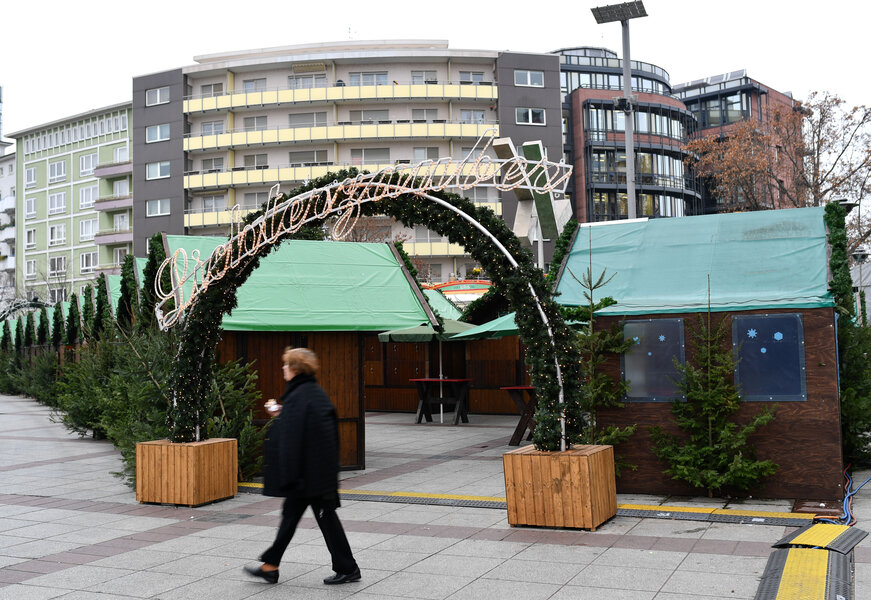A 12-year-old in Germany tried to bomb a Christmas market. How do we talk about that?
Loading...
A 12-year-old boy from the German town of Rhineland-Palatinate is suspected of trying to detonate a homemade combustible on two separate occasions at the behest of an Islamic State member, as investigators told German media.
German police say the boy first tried to set off the device – a primitive nail bomb made using powder from fireworks and sparklers, which proved flammable but not explosive – in late November near a Christmas market in Ludwigshafen, before trying and failing again on Dec. 5 near a city hall, according to the Local. In the second instance, a pedestrian alerted police after spotting the bag.
Prosecutors won’t pursue the case, since the suspect is under age 14. But the IS connection seems likely to cause waves among a German public nervous about its government’s liberal refugee policy, particularly after a handful of attacks linked – sometimes erroneously – to newcomers. The boy was born in Germany to Iraqi parents, and according to Focus magazine, which broke the story, investigators have said he could have been radicalized by an “unknown” IS agent.
The case may raise questions about how members of the press, lawmakers, and citizen activists should treat such incidents, in an age when both the political class and the media are often accused of covering up or downplaying their political implications.
“There’s a huge number of potential factors involved,” says Theodore Petti, a psychiatry professor at Rutgers University’s Robert Wood Johnson Medical School in New Brunswick, N.J. A past trauma, issues with development, bullying or noxious social media could all be at play, he tells The Christian Science Monitor.
Mia Bloom, a professor of communications at Georgia State University who studies extremist ideology and child recruitment, tells the Monitor she disagrees with investigators’ characterization of the boy as “radicalized.”
“I don’t think a 12-year-old can be radicalized,” she says.
“I can see how this potential story is going to be, ‘This is why we can’t let refugees into the country, not even the children, because the children are radicalized,' which is why I oppose a priori the police assessment.”
Germany’s press corps, unusually sensitive to any hint of inciting fervor against outsiders, have come under particular scrutiny for their coverage – or non-coverage – of crimes committed by migrants and refugees, reported the Monitor’s Sara Llana Miller and Rachel Stern on Dec. 12:
Last week, Germans learned that the lead suspect in the October rape and murder of a 19-year-old medical student in Freiburg, in southwestern Germany, arrived in 2015 as an unaccompanied Afghan refugee. The case has thrust Germany into yet another public debate about whether highlighting crimes by migrants and refugees stokes fears – and whether not doing so amounts to self-censorship.
But analysts point to a “learning moment,” too. The lead broadcaster chose not to cover the murder amid a rain of accusations of liberal bias, but it accompanied that decision with a public explanation of its reasoning.
…
Leonard Novy, an analyst at the Institute for Media and Communications Policy in Cologne, says all “practices of representative democracy” are being challenged – from mainstream politics to the mainstream media – in ways “we are only just beginning to fathom.”
But media attention on incidents like the one in Ludwigshafen, says B. Heidi Ellis, the director of the Refugee Trauma and Resilience Center at Boston Children’s Hospital, do help generate stigmatization – what her research on violent extremism show as a main cause in why young people get involved.
“We’re creating our own problem,” she tells the Monitor. “I wish some of these articles would focus on, ‘What’s wrong with the 12-year-old?’”
“There are 12-years-olds out there who do things – sometimes they get drawn into a gang, commit violence in a gang, and it doesn’t make international news, probably not even local news.”
Whether or not children can be radicalized, however, their age may make them strategic instruments for violent groups.
"Security officials are checking whether ISIS is targeting children and adolescents for potential terror attacks in Germany and Europe because they are least expected to commit violent acts," said Elmar Thevessen, the deputy editor-in-chief of German broadcaster ZDF, according to NBC.








